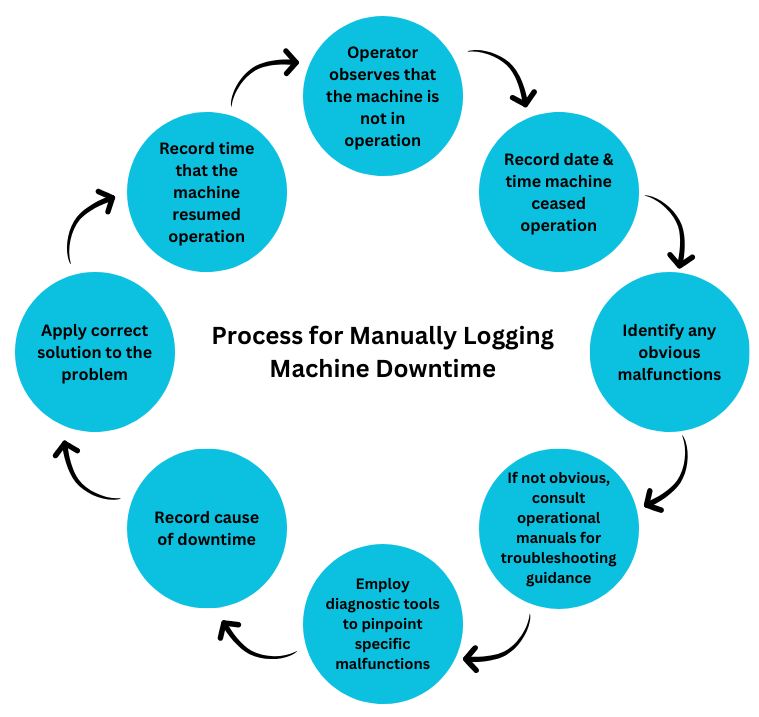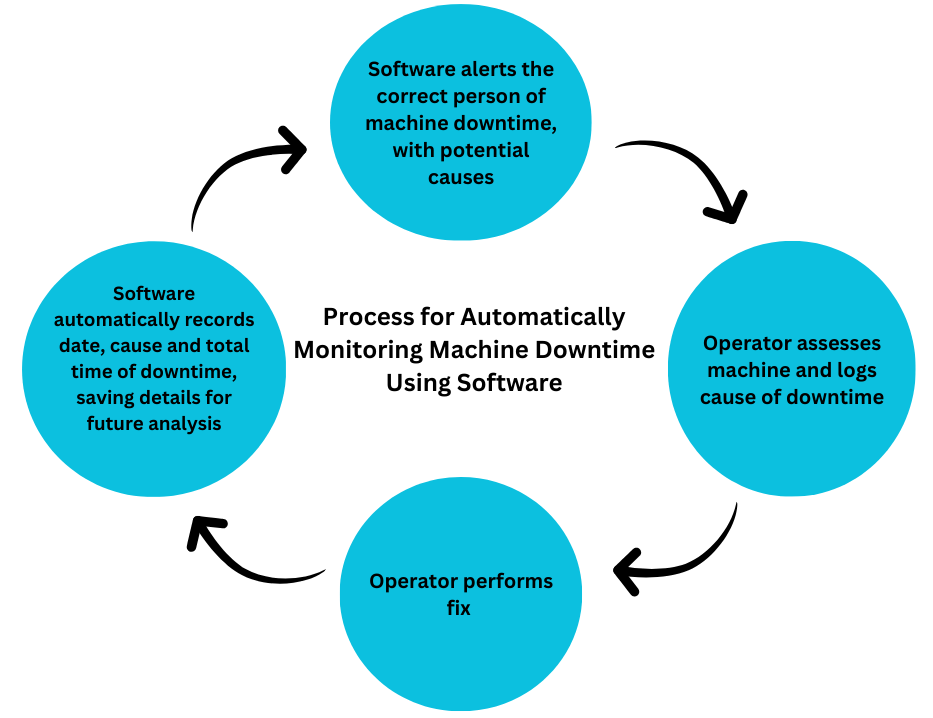Machine downtime in manufacturing is a critical issue that significantly impacts productivity and profitability. Machines are the backbone of any manufacturing business, and if they aren’t operating, you aren’t making money. Therefore it’s essential to have a plan in place to accurately track this important metric, and be able to successfully analyse the data in order to improve your rate of downtime.
There are two ways to monitor downtime, manually or using technology. This blog post will discuss the tracking process, how you can analyse data, and the pros and cons of both methodologies.
Understanding Machine Downtime
Machine downtime is essentially any time that a machine is not in operation. This can be categorised in two ways; planned or unplanned down downtime. Planned downtime is any pre scheduled activity that you know will take place, including maintenance, changeovers and inventory top ups. Unplanned downtime is therefore anything which occurs unexpectedly, and includes machine failures, operator errors or staffing/inventory issues.
For further information on the impacts of downtime, check out our comprehensive guide to machine downtime.

Manually Logging Downtime
Tracking data
Most organisations begin their downtime tracking journey with basic manual logging. This serves as a basic entry point, where employees document downtime incidents along with their durations and causes. This may be through their own custom MES and/or ERP system, or through simple excel or Google spreadsheets. This is a cost effective solution for businesses just starting out, and can still provide some useful data.
The process for manually logging downtime will look something like this:

Despite its apparent simplicity, the above shows that it’s not actually a very quick process. There’s a lot of time and energy that goes into identifying and fixing the problem, and this method often falls short in terms of accuracy and reliability.
Analysing Data
In order to get actionable insights from your downtime data, you would need to manually carry out the following activities:
- Pareto Analysis- A Pareto analysis can be applied to the collected downtime data to identify the most significant causes of downtime. By categorising downtime reasons and calculating the frequency and duration of each category, organisations can identify the 'vital few' issues that contribute to the majority of the downtime. This method helps focus improvement efforts on areas that will have the greatest impact.
- Trend Analysis- Trend analysis involves reviewing downtime records over a specific period to identify any patterns or trends. This might include increased downtime due to specific machines, shifts, or times of the year. Identifying these trends manually requires sorting through logs and plotting data over time, offering insights into potential systematic issues or the need for preventive maintenance.
- Root Cause Analysis (RCA)- Once data is collected and preliminary analyses have been performed to identify critical areas of concern, teams must conduct root cause analyses on the most problematic areas. Techniques like the 5 Whys or fishbone diagrams (Ishikawa) help drill down to the underlying reasons for downtime. This process involves team discussions and brainstorming sessions to explore all possible causes of a problem.
- Time Motion Studies- Time motion studies involve observing and recording the time taken for different processes and when downtime occurs. This method can help identify inefficiencies in the workflow or processes that contribute to increased downtime. Analysing these studies requires a systematic approach to observe, document, and evaluate each step of the operation.
- Capacity Utilisation Analysis- This involves calculating the ratio of actual output to potential output to identify how much downtime is affecting overall capacity. By manually reviewing production records and comparing them to the machine or line's theoretical output, organisations can quantify the impact of downtime on productivity.
Sounds like a lot doesn’t it? This would easily be enough work to fill a full time position, potentially two. This would require experienced data analysts, which would cost you an average of £45,000 per year per person.
Pros of Manually Tracking Machine Downtime
The pros of manually tracking machine downtime is that it doesn’t require investment into new software. Most production monitoring software can cost anywhere from £10,000 to £50,000 per year. For a lot of companies just starting out, this would be outside of their budget, so manually recording and analysing your data allows you to save on outgoings. whilst. Manually recording your data also helps to upskill your employees, as they will often need training to learn how to identify signs of malfunction, and to learn how to analyse data sets.
Cons of Manually Tracking Machine Downtime
On the other hand, it’s easy to miss things if you are manually tracking and analysing data. It is almost impossible to have an individual monitoring every single station throughout every minute of the shift. This can lead to gaps in data collection and will then make analysis difficult, as you are working with incomplete data. If you're missing things in data, then you're missing out on opportunities to reduce downtime and improve profits.
It also puts a lot of pressure on employees to be looking for and tracking the right things. If employees frequently find they cannot identify the problem and fix it straight away, then this can reduce team morale.
Finally, you may feel like you are making savings by not investing in software, but there are many hidden costs. This method is very time consuming and can significantly increase the overall duration of downtime, decreasing profit margins. As mentioned previously, you’d also have to either employ full time data analysts, or put your staff through extensive training, which would both wipe out any savings you make from not investing in a simple piece of software that can do it all for you.
Technology and Software Solutions
Tracking Data
The second way in which you can track downtime is by using custom software. Production monitoring software enables real-time monitoring and analysis of data, which facilitates immediate response to downtime incidents. IoT devices are connected to your machines which collect production signals that are used to confirm a machine is in operation. If the software does not receive these signals, it sends immediate alerts. Busroot, our production monitoring software, can set up custom workflows so that the correct person is alerted every time. It also offers potential causes of downtime, which is extremely valuable for troubleshooting and getting the machine back in operation as quickly as possible.
The process for tracking downtime using software will look something like this:

As you can see, using software requires much less input and time from employees, resulting in a significant reduction in downtime, which in turn increases the rate of production and improves profit margins. The software allows you to take a step back and focus on things that really matter.
Analysing Downtime Data
A software like Busroot can analyse your downtime data and instantly identify trends and patterns. These patterns of downtime are then used to predict when a machine is likely to break down and require maintenance, therefore allowing you to get in there before it causes any issues. This creates a culture of proactivity, vs reactivity, and this is essential for reducing unplanned downtime and increasing availability.
However, softwares like Busroot can not only analyse your downtime data, but they can also analyse your data against a whole host of other metrics. This includes:
- OEE
- Cycle Time
- Asset Utilisation
- Energy Consumption
- Waste
Not only are you getting information on downtime, but you are getting several other data points, which will significantly streamline and improve your production efficiency. Production monitoring platforms can also be easily integrated with any MES or ERP solutions, so that you can consolidate all of your data and use it to improve strategic decision making.
Pros of Using Software To Track Machine Downtime
The main advantage of using advanced technology to track and analyse your machine downtime is the amount of time you save. You do not need employees to be monitoring machines 24/7, identifying the cause of failures is much quicker, and they do not need to spend hours analysing your data. Everything is done automatically, which provides a huge time and cost saving. It also enables you to get your machines back up and running much quicker, which improves production rates and overall profit margins.
Similarly, being able to create a proactive approach allows maintenance to be scheduled at the most opportune times, reducing unplanned downtime and extending the life of machinery. Predictive maintenance not only enhances operational efficiency but also optimises maintenance resources, leading to significant cost savings. The software also focuses on aspects such as quality and improving cycle time, which also improves profit margins.
Finally, it also takes a lot of pressure off employees, as they are no longer responsible for monitoring the entire shop-floor. They can focus on more strategic and value-added tasks, whilst not having to focus on lots of things at once, which should in turn lead to higher job satisfaction. And if employees do want to get more involved with the software, they can be given extra training which can also lead to higher job satisfaction and retention.
Cons of Using Software To Track Machine Downtime
The only negative side of investing into advanced production monitoring software is that there is a cost to it. However, as mentioned previously, the investment is quickly returned as you save money on training costs, data analysts, reduced downtime, and increased efficiency.
For example, the average cost of downtime in the manufacturing industry is a whopping £260,000 per hour. Investing in Busroot will only set you back £10,800 per year for 6 machines at £150 each (check out our pricing here). So, if you reduce downtime by even a couple of hours per year, you will be getting that investment back straight away, plus a great deal more!
Overall, tracking and analysing machine downtime is a complex but essential activity. It enables you to identify the key causes of your machine failures and use this information to improve efficiency. While manual logging offers a basic entry point for data collection, it requires extensive effort and can lead to inaccuracies. Advanced technology and software solutions provide real-time monitoring, predictive maintenance, and comprehensive analysis, greatly enhancing operational efficiency. Despite the initial investment, the long-term benefits of technological approaches justify the cost, marking a crucial step towards a proactive and competitive manufacturing environment.


